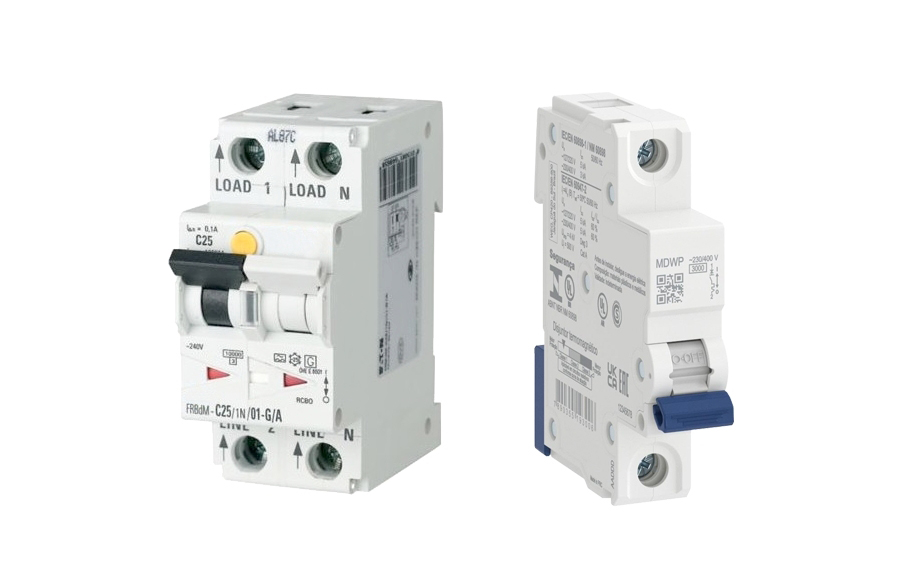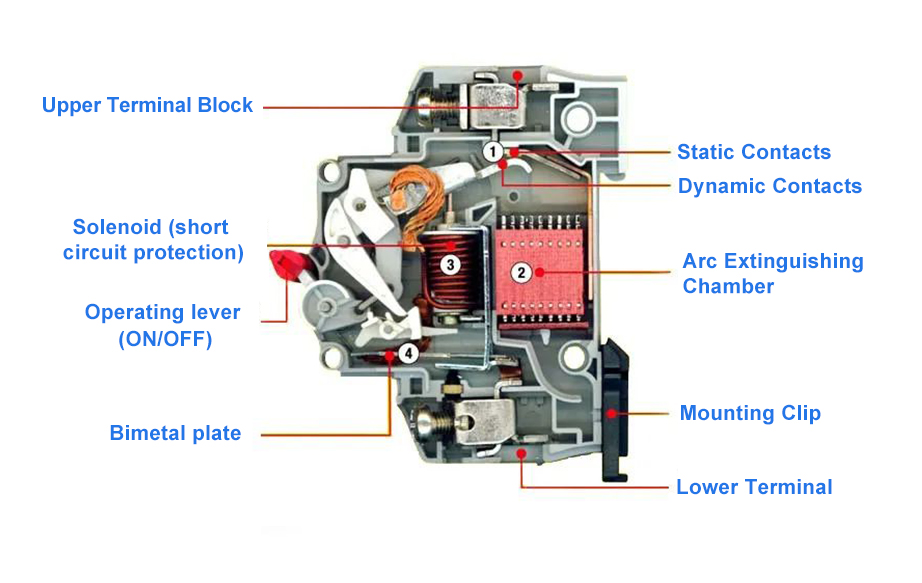icro Circuit Breaker (MCB for short) is one of the most widely used terminal protection appliances in electrical terminal power distribution devices. It is usually used for single-phase and three-phase short circuit, overload and over-voltage protection below 125A, and is generally available in single-pole, double-pole, three-pole and four-pole options. The main function of miniature circuit breaker (MCB) is to switch the circuit, i.e. when the current through the miniature circuit breaker (MCB) exceeds the value set by it, it will automatically break the circuit after a certain delay time. If required, it can also switch the circuit on and off manually like a normal switch.
Miniature Circuit Breaker (MCB) Structure and Working Principle
Miniature Circuit Breakers (MCB) are made of thermoplastic insulating material molded in a housing which has good mechanical, thermal and insulating properties. The switching system consists of fixed static and moving movable contacts with contacts and output wires connected together and to load terminals. The contacts and current-carrying parts are made of electrolytic copper or silver alloys, the choice of which depends on the voltage-current rating of the circuit breaker.
When contacts separate under overload or short circuit conditions, an arc is formed. Modern miniature circuit breaker (MCB) are used to interrupt or eliminate the arc design, arc energy absorption and cooling by the arc extinguishing chamber in the metal arc spacer to realize, these arc spacers with insulated bracket fixed in the appropriate position. In addition, the use of conductor circuit electric power (circuit breakers now more current-limiting structure to enhance the breaking capacity of the product) or magnetic blowing, so that the arc quickly moved and elongated, through the arc flow channel into the interrupter chamber.
Miniature circuit breaker (MCB) operating mechanism consists of solenoid magnetic release device and bimetal thermal release device. The magnetic stripping device is actually a magnetic circuit. When normal current is passed in the line, the electromagnetic force generated by the solenoid is less than the spring tension to form a reaction force, the armature cannot be sucked by the solenoid, and the circuit breaker operates normally. When there is a short-circuit fault in the line, the current exceeds a number of times the normal current, the electromagnetic force generated by the electromagnet is greater than the reaction force of the spring, the armature is sucked by the electromagnet through the transmission mechanism to promote the free release mechanism to release the main contacts. The main contact is separated under the action of the breaking spring to cut off the circuit to play the role of short-circuit protection.
The main component in the thermal release device is the bimetal, which is generally pressed from two different metals or metal alloys. Metal or metal alloy has a characteristic, that is, different metal or metal alloy in the case of heat, the expansion of the volume change is not consistent, so when it is heated, for the two different materials metal or alloy composition of the bimetallic sheet, it will be to the expansion coefficient of the side of the low side of the bending, the use of curvature to promote the release of the rod rotary movement, the implementation of the release tripping action, so as to realize the overload protection. Since overload protection is realized by thermal effect, it is also known as thermal release.
Selection of 1, 2, 3 and 4 poles of miniature circuit breaker
Single-pole miniature circuit breakers are used to provide switching and protection for only one phase of a circuit. These circuit breakers are mainly designed for low voltage circuits. These circuit breakers help in controlling specific wires, lighting systems or outlets in the home. These can also be used for vacuum cleaners, general lighting outlets, outdoor lighting, fans and blowers etc.
Double pole miniature circuit breakers are usually used in consumer control unit panels such as main switches. Starting from the energy meter, the power is dispersed throughout the circuit breaker to different parts of the house. Double pole miniature circuit breakers are used to provide protection and switching for phase and neutral wires.
Three-pole miniature circuit breakers are used to provide switching and protection for only the three phases of a circuit, not the neutral.
A four-pole miniature circuit breaker, in addition to providing switching and protection for the three phases of a circuit, has a protective striker primarily for the neutral pole (e.g., N pole). Therefore, a four-pole miniature circuit breaker must be used whenever high neutral currents may be present throughout the circuit.
Miniature circuit breaker A (Z), B, C, D, K type curve selection
(1) A (Z) type circuit breaker: 2-3 times rated current, rarely used, generally used for semiconductor protection (fuses are normally used)
(2) B-type circuit breaker: 3-5 times the rated current, generally used for pure resistive loads and low-voltage lighting circuits, commonly used in the distribution box of households to protect household appliances and personal safety, less used at present.
(3) C-type circuit breaker: 5-10 times the rated current, need to be released within 0.1 seconds, the characteristics of the circuit breaker is most commonly used, commonly used in the protection of distribution lines and lighting circuits with high turn-on current.
(4) D-type circuit breaker: 10-20 times the rated current, mainly in the environment of high instantaneous current of electrical appliances, generally less used in the family, for high inductive loads and large inrush current system, commonly used in the protection of equipment with high inrush current.
(5) K-type circuit breaker: 8-12 times the rated current, need to be in 0.1 seconds. k-type miniature circuit breaker’s main function is to protect and control the transformer, auxiliary circuits and motors and other circuits from short-circuit and overload. Suitable for inductive and motor loads with high inrush currents.
Post time: Apr-09-2024




